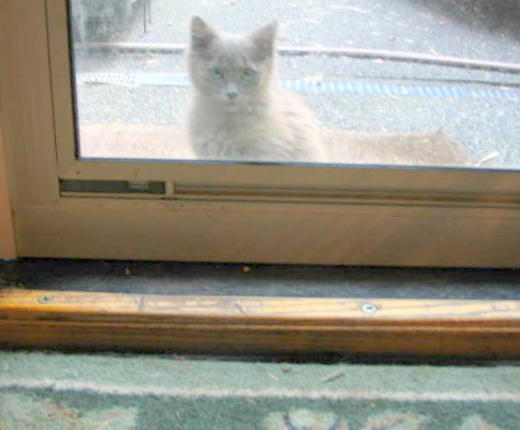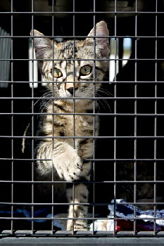Feral Cats

Domestic cats which have reverted back to a wild state are basically feral cats. The first generation starts off with pets which have been abandoned or lost. When they have kittens, they teach them to be wary of humans and to defend themselves. A lost or abandoned housecat will survive an average of only 2 to 4 years away from home. A typical litter can lose 50% shortly after birth and the rest may fall victim to disease, predation, and starvation, and the ever-present threat of cars.
Females spend most of their lives pregnant and hungry. Most female wild animals are pregnant every year. Unneutered toms get into fights, and the resulting untreated wounds can eventually kill them.
Feral cats can produce up to three litters of several kittens per year and they can start as young as 4 months. One unspayed female and her offspring...then their offspring etc. can produce 420,000 feral cats in 7 years. Wild cats face a life of cold, hunger and the struggle for survival.
You can't just trap the cats and take them to a shelter because a very high percentage will just be euthanized. In crowded shelters, the feral cats go first. Instead of reducing their numbers, killing simply makes room for new cats to move in, and the breeding process begins all over again.
A solution: Trap-Neuter-Return
Trap-Neuter-Return or TNR, means that volunteers trap the feral cats, have them spayed or neutered, and then return them to their original colony. This stabilizes the feral population and improves the overall health of the colony. Also see Cat Colonies
First of all, if you want to help be aware of what you're getting into. It is suggested that you call your city hall and find out your town's rules and regulations about outdoor animals. Even if you go to the trouble of trapping and neutering feral cats, they still might be impounded and euthanized. You may need to give them a tag and a license, but that makes you just as responsible for them as one of your own pets.
Then you must see that they get adequate food and water, vaccinations and medical examinations. If the cat seems ill-treated, you may have to answer to animal cruelty charges. If the cat attacks your neighbor's pet rabbit, you're the one that goes to court. Alley Cat Allies warn that your town may be less than helpful.
Most animal control agencies have no policies or programs to assist outdoor cats in need or the people who want to help them. They may even fine you for feeding the feral cats. Still, it's better to get started than do nothing at all. Deal with any problems as they arise and frequently they may not. If you encounter red tape, contact Alley Cat Allies for assistance. They have helped to get some of these ordinances changed. Another valuable resources is Feral Cat Coalition
Or, you may find a group or shelter in your own area that wants to help. Then, there's the financial investment for the neutering and veterinarian visits. If you get a deal from a low-cost spay-neuter clinic, you can expect to pay less than a regular veterinarian where it can run $100-$250. There are a handful of free clinics but you'll have to check if there are any in your area. However, a trusted group called Homeward Pet Adoption periodically offers $25 spays.
Feral cats usually congregate near a food source
You can find feral cats at night and during early morning and twilight hours. Colonies usually congregate near a food source, such as garbage dumpsters in alleys, in parks, and behind restaurants, food shops, hospitals and cafeterias. Before you trap, evaluate whether the cats are in a safe location.
If not, you may want to release them elsewhere. Keep in mind, though, that even if you remove feral cats from a location, others will simply take their place as long as there's food available in the area.
Get help from experts before undertaking such a project. Most often, the cats are better off where they are. If you want to relocate one or several cats, call feral cats organizations for guidance. You also don't want them fighting with resident cats or otherwise being a nuisance for humans in the new location.
Generally, if relocating them, look for farms or property with acreage where the owner is agreeable. There's generally no problem with current resident wild cats as long as the new cats are given their own feeding area and shelter.
- Make arrangements for the exam and neutering with a veterinarian, but tell them beforehand that the cat is feral and make sure they have experience with feral cats.
- Get a pre-exposure rabies vaccination and update your tetanus shots.
- Have a game plan. Trapping a cat the wrong way will frighten the cat, at best. In rare circumstances, cats have been injured or worse. If you mess up, you probably won't be able to catch the same cat twice. Feral cats learn very quickly.
- Get the cats used to being fed at the same place and time of day.
- Leave the unset trap in the area, covered with a large towel so that the animal will get used to seeing and smelling it.
- Don't feed the cats the day before trapping so they'll be hungry.
Trapping ... Catching ...Feral Cats
Where to get a trap? Various humane traps are available for sale or rental. Most traps and carriers can be purchased, prices vary...but some clinics will let you borrow theirs for free. If you can get near the cat, you can try using a regular cat carrier instead of a trap if you're careful.
- It's best to trap the night before surgery, at the cat's normal feeding time. Line the bottom of the trap with newspaper, just covering the trip plate. Make sure it doesn't block the mechanism. Then place the trap on a level surface in a secluded spot.
- If you want to be sure of success, don't use cat food. Bait the trap with sardines or tuna...something they really want. Place the food on a small scrap of paper, as far back in the trap as possible while still inaccessible from outside. This will make the cat go all the way in and stay there long enough to trip the mechanism. Set the trap according to the instructions, and cover all but the opening with a large towel. This will be added camouflage and will help to calm the cat after it's caught.
- Wait quietly in an area where you can still see the trap without disturbing the cat. Check the trap every 15 minutes or so; you may hear it trip.
- After you have the cat, place the trap or carrier in a protected area, such as a basement or garage, while waiting for the veterinarian appointment. Find out about food and water restrictions before surgery. Keep the cage covered and check it periodically, but don't stick your fingers in the trap or allow children or pets nearby.
Once caught...keep the cat in the trap
When going to the veterinarian be sure to keep the cat in his trap. Letting him (or any cat) run loose in your car will make driving hazardous. Many feral cats programs require that feral cats are brought in traps only, not carriers. Vets and their staff must be able to anesthetize through the wires. Although most of us think of any cat under a year old as a kitten, cats can reproduce before they're 5-6 months old.
Kittens can be safely sterilized from 8 weeks of age but be sure to ask the vet if he's comfortable neutering a cat that young...not all vets are. Remember, although it may be sad, pregnant females can also be spayed. Many clinics and veterinarians offer discounted neutering, especially if you don't have much income. Contact the organizations listed above for more information.
An important part of the TNR process is ear tipping, used to identify cats that have been neutered so they aren't re-trapped. Feral cats cannot be collared and ear-tags can be torn off causing injury and infection. Ear tipping is done when a cat is neutered and while under anesthesia. The vet clips about 1/4 inch off the tip of his left ear and this lets caretakers know that the cat has already visited a vet, and thus is to be released. If a cat doesn't seem to be recovering from the surgery, bring him in for another checkup before releasing him.
Each cat should receive a physical and a rabies vaccination at the same time as its neutering appointment. Some experts suggest you test four of the cats in a colony for feline immunodeficiency virus (FIV) and feline leukemia virus (FeLv) as a sample. However, others would test only symptomatic animals and put more money into neutering. If a cat has a serious medical problem, you have a serious decision to make.
Unless you are relocating a whole colony, release the cat where he was captured. Make sure you're not encouraging him to run into danger on a busy street in his excitement to get away. Keep the trap covered until you're ready. Hold the trap with the door facing away from you, and open the door. The cat will probably bolt out immediately.
If he doesn't want to leave, tip the back of the trap slightly up and tap on the back, or prop the door open with a stick and leave it for a while. Don't worry about the cat attacking you...he'll just want to get as far away from you as possible. After releasing the cats, hose off the traps and disinfect them with bleach. Never leave traps open and set; animals may wander in and starve to death.
Shelter from storms is important for feral cats
If a safe existing shelter or building is available, assess its ability to keep cats warm and dry during winter months. If no such shelter exists, you may want to build one. Check with your local animal shelter for guidelines. Most of those people are animal lovers and may let you know an organization that can assist. Some agencies find farms through newspaper ads where the cats can live out the remainder of their lives, happily working for room and board by keeping small four-legged pests away.
If you have feral cats that you would like to set up as farmhands, call an organization that does this regularly and has an ongoing relationship with the farms. Becky Robinson, the President of Alley Cat Allies, cautions, "If the process isn't done properly...cats are to be confined for 21 days...the cats will be worse off than if they had been left at the original site.
If you're tempted to bring a feral cat inside, it may not be a good idea. They're unhappy being confined and may destroy the house trying to get out. And if they succeed in getting through the screen, which most do, they may be unsuccessful in returning to their colony if it's more than a few blocks away. The younger feral cats have the most promising futures as house cats. Although kittens as young as 3 weeks old may hiss and bite, these instincts will only grow stronger with age. Over 12 weeks, trying to domesticate them becomes more difficult, though it can be done.
My adorable Chanel is a prime example. It took months before we could take her out of a small "safe room". She learned to be touched and held while feeling safe in the small area and months later she was finally introduced to the rest of the house and the other cats. If you're going to attempt this, be realistic about the time commitment and the possible results.
In fact, even after taming feral kittens, many have feral tendencies like running and hiding when anyone comes to visit. With Chanel, just the sound of someone coming to the door and she's ducked under the sofa into her security spot.
Don't rescue any kittens unless you're certain you can find homes for them
Changing owners can make the cats revert to their wild state for months before they can bond again. Also, if you tame more kittens than you have homes for, you may find yourself running a miniature shelter. The kittens may look innocent, but feral mother cats are very protective, and kittens themselves often bite and scratch. When removing kittens from their mother use gloved hands or a baited trap.
A vet visit is a must...expect internal parasites, ear mites, upper respiratory infections and ringworm, as well as FIV/FeLV. The process of taming kittens can take 2-6 weeks or several months if they are older like my Chanel was. I thought she was only 2 months old because she was only 2 1/2 pounds but she was actually 6 months old and was starving to death. My vet said to give her lots of groceries and she doubled her weight in a month. She's almost 3 years old now and a beautiful, healthy animal.
Helping feral cats can be a lot of work. But remember, you need not adopt a colony. If you have limited time or money, you can assist in other ways. Help out at the local shelter, donate to groups like Alley Cat Allies, and PAWS , share a colony upkeep with neighbors, or just take things one cat at a time. Remember...you can't save them all...but you can do something.
LOOK OUT FOR RISKS WITH FERAL CATS
Don't worry too much about feral cats attacking you. They're terrified of you, and will only bite or scratch if provoked. The greater threat is disease. If you're handling the cats, wash extremely well before handling your own cats. It may sound like overkill, but you may even want to change your clothes.
Cats can sneeze on your clothing, and disease can be transmitted that way. For instance, FeLV can be transmitted by saliva and transferred to other cats. It's not just your pets at risk, some diseases can be passed from animals to humans.
- Territory Issues: Most feral cats won't even allow themselves to be touched, much less settle into your home as a house cat. If you try to take one in, remember that the cat is used to having total freedom. His territory may have extended for a couple of blocks. Now he's limited to half an apartment or house. This can make for some nasty fights with other cats present. Generally, introducing feral cats to your own home cat members is a bad idea, at least until they start showing signs of becoming tamer.
- Bites and Scratches: In making contact let the cat set the pace, or you may get scratched or bitten. Wear padded gloves and long sleeves as a precaution. Feral cats can inflict some serious damage. If a cat bite breaks the skin, wash it well and go immediately to a doctor. Cat nails and teeth harbor bacteria, and the risk of infection is very high. If you get scratched, wash out the wound well and keep and eye out for infection and fever.
- Rabies: Rabies, though feared, is relatively rare among humans. Still, you might want to get a pre-exposure vaccination, and have all ferals vaccinated. Any cat who bites a human must be quarantined and examined. Infected cat scratches can cause lymph node enlargement, fever, fatigue, sore throat, and headaches. If you're scratched, immediately wash the wound and contact your doctor if any symptoms occur.
- Chlamydiosis: Felines who have this upper respiratory infection can pass it to humans in the form of conjunctivitis(pinkeye). Don't touch your eyes after contact with feral cats.
- Fleas and Ticks: Feral cats may carry fleas and ticks infected with Lyme disease, which could transfer to humans and other animals. Check your whole body carefully after spending time in an area of feral cats, especially if tall grass is present. If you find a tick, send it to a testing center to determine if it's a carrier. You may want to spray the area for fleas and other pests.
- Ringworm:Ringworm is actually a fungus and can be transferred to both humans and other animals. It makes cat fur fall out in a circular area, and the skin underneath will look red. Wearing gloves will protect you.
- Many internal parasites live in cat feces. Toxoplasma dondii is a particularly nasty one that can be passed on to humans. In pregnant women it can lead to abortion or fetal abnormalities. If you're pregnant, have someone else clean the litter box, and wear gloves when handling feral cats. Everyone should wear gloves and wash their hands well after cleaning litter boxes.
Cleanliness and a little precaution will reduce or eliminate most health risks, Make sure to clean up left-over food and keep cat feces areas clean.
Related Articles......
Return from Feral Cats to Cat Health Homepage
Having trouble finding what you need? Cat Health Index & Site Map
OR
Do you have a question to ask?...Questions
OR
Do you have a cat story to share?...Simply click here to go to that page!
Copyright@2010-2020 All rights reserved.Cat-health-detective.com
This website is information only. Consult a veterinarian for medical assistance

"Like Us" on Facebook
or...
"Like Us" here




















